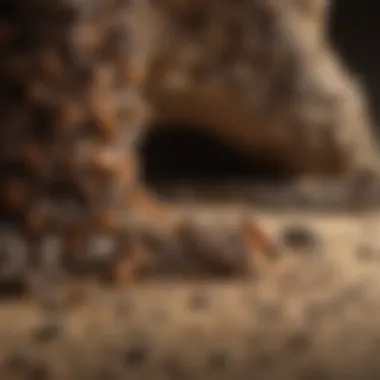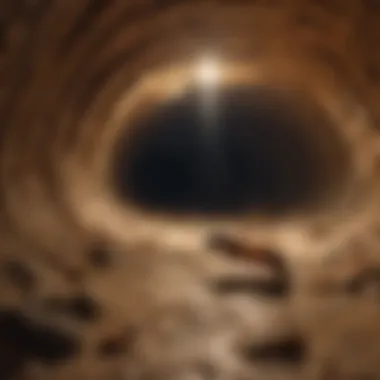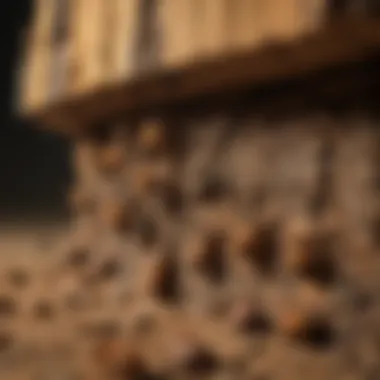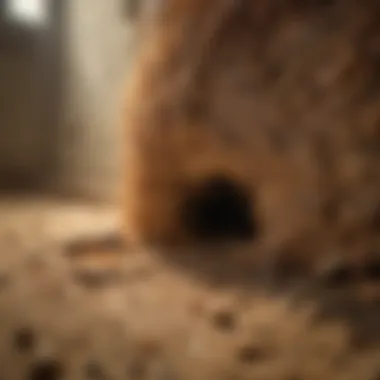Understanding the Impact of Subterranean Termites in California: A Detailed Analysis


Preventive Pest Control Strategies
Ensuring your home remains a sanctuary free from the invasive presence of subterranean termites requires a meticulous approach to preventive pest control strategies. It starts with fortifying your house inside out, starting with the exterior protection. Seal all cracks, crevices, or tiny openings that could be potential entry points for these relentless pests. Clearing debris from your surroundings not only enhances the aesthetics of your property but also eliminates termite attractions. It's pivotal to impede pests from encroaching on your living space by employing effective barriers.
House Exterior Protection When pondering ways to safeguard your premises against the stealthy invasion of subterranean termites, attention to detail is paramount. Securing your house exterior involves not only enhancing its visual appeal but also creating a formidable defense barrier against unwelcome pests. Start by diligently examining your property for any cracks that might serve as gateways for termites. Sealing these openings promptly with appropriate materials can significantly impede termite intrusion. Next, prioritize the removal of debris and unnecessary vegetation near your property. By maintaining a clean and clutter-free exterior, you eliminate potential hiding spots and food sources for termites. For a comprehensive defense strategy, consider investing in professional pest barriers to inhibit termite access into your home environment.
Yard Maintenance A well-maintained yard not only augments the beauty of your home but also plays a pivotal role in deterring subterranean termites. Incorporate essential yard care routines into your schedule to minimize termite attractions and breeding grounds. Regularly mow your lawn, trim overgrown vegetation, and dispose of yard waste promptly. By ensuring proper drainage and addressing moisture-prone areas, you create an unfriendly environment for termite infestations. Implementing pest-resistant landscaping techniques can further enhance the defense mechanisms of your property.
Indoor Cleanliness The battle against subterranean termites extends beyond your exterior to the indoor sanctity of your living space. Maintaining pristine indoor environments not only promotes overall well-being but also mitigates the risk of termite infestations. Adopt expert cleaning tips and techniques to eliminate food sources and shelter for termites within your home. Regularly vacuuming, dusting, and decluttering can deter pests from establishing colonies indoors. Embrace a pest-resistant mindset by sealing off potential entry points like gaps around pipes, windows, and doors. By upholding high standards of indoor cleanliness, you fortify your defense against subterranean termites and other pests.
Garbage Disposal The menace of subterranean termites lurks not only in plain sight but also within our waste disposal habits. Efficient garbage disposal methods are indispensable in curbing termite activities around your property. Proper waste management not only enhances hygiene but also reduces enticing factors for termites. Segregate your waste into organic and inorganic categories to facilitate appropriate disposal practices. Regularly emptying trash cans, securing bins, and maintaining cleanliness in waste storage areas can go a long way in deterring pests. Emphasize the significance of proper garbage disposal to all household members to cultivate a collective effort in pest prevention.
Other Pest Prevention Strategies Beyond the conventional approaches to pest control lie innovative methods of safeguarding your home against subterranean termites. Implementing a multi-faceted pest prevention strategy involves a holistic assessment of your property's vulnerabilities and strengths. Explore innovative solutions such as natural repellents, barriers, and deterrents to create an unwelcoming environment for termites. Adopting sustainable practices like composting, water conservation, and eco-friendly architecture can further fortify your pest defense mechanisms. By integrating various pest prevention strategies tailored to your specific needs, you elevate your home's resilience against subterranean termite incursions.
Foreword
Overview of Subterranean Termites
What are Subterranean Termites?
A key facet of the subterranean termite enigma lies in their cryptic nature and subterranean lifestyle. These insidious insects thrive in dark, humid environments, making human dwellings an ideal habitat. Their intricate social structure, with distinct castes responsible for various tasks, facilitates efficient colony functioning. The ability to consume cellulose with the aid of symbiotic microorganisms sets them apart from other termite species. This unique trait enables subterranean termites to target a wide array of wooden structures with alarming precision.


Importance of Studying Subterranean Termites
The significance of delving into the realm of subterranean termites transcends mere academic interest. By unraveling their enigmatic behaviors and ecological roles, researchers gain invaluable insights into ecosystem dynamics and pest management strategies. Studying these pests offers a window into understanding evolutionary adaptations and cohabitation challenges posed by invasive species. Proactively addressing the impact of subterranean termites is paramount to safeguarding California's architectural heritage and ecological balance.
Distribution in California
Common Areas Affected
The prevalence of subterranean termites in California is a pressing concern for homeowners across a myriad of regions. Coastal areas with moderate temperatures and high humidity levels provide an ideal breeding ground for these voracious pests. Urban centers and suburban neighborhoods alike fall prey to the relentless infiltration of termite colonies, resulting in substantial property damage. Vigilance in monitoring vulnerable structures such as foundations, wooden beams, and attics is imperative to detect early signs of infestation.
Impact on Different Regions
The impact of subterranean termites manifests diversely across California's varied regions, influenced by climatic nuances and soil compositions. From the damp coastal plains to the arid interiors, the presence of these destructive insects poses a common threat to structural integrity. Rural communities and agricultural landscapes bear the brunt of termite-induced degradation, necessitating concerted efforts in pest control and prevention measures. Awareness of regional differences in termite behavior is essential for implementing targeted management strategies to mitigate the proliferation of these clandestine marauders.
Behavioral Patterns
Foraging Behavior
Foraging behavior is a pivotal aspect in the lifecycle of subterranean termites. Their feeding habits significantly impact the extent of damage they can cause to structures. Termites primarily feed on cellulose present in wood and other plant materials, making them efficient decomposers. This feeding strategy allows them to break down organic matter effectively, yet poses a significant threat to wooden structures. Their ability to locate food sources through chemical cues highlights their sophistication in exploiting resources efficiently.
Nesting Habits


Understanding the nesting habits of subterranean termites sheds light on their colony structures and construction methods. Subterranean termite colonies consist of multiple castes working together to ensure survival and reproduction. The division of labor within these colonies enables them to efficiently carry out tasks such as foraging, caring for young termites, and expanding the nest. The construction of mud tubes, a distinguishing feature of subterranean termites, serves as a protective pathway for termites to navigate between their nest and food sources. While these mud tubes provide them with security, they also serve as visible indicators of termite activity, aiding in detection and control efforts.
Subterranean Termite Colonies
Subterranean termite colonies exhibit a complex social structure comprising workers, soldiers, nymphs, and reproductives. Each caste has specific roles and responsibilities vital for the colony's survival. For example, workers are tasked with feeding other members, caring for the young, and constructing tunnels, while soldiers defend the colony against predators. The collaborative nature of termite colonies ensures efficient resource utilization and protection against external threats.
Construction of Mud Tubes
The construction of mud tubes is a key nesting behavior employed by subterranean termites. These tubes provide them with moisture-regulated environments necessary for their survival. By utilizing soil, wood particles, and saliva, termites construct these tubes to create sheltered pathways free from predators and environmental fluctuations. Despite their structural benefits for termites, mud tubes serve as visible signs of infestation, alerting homeowners to potential termite presence and prompting timely action for control and prevention.
Damage Assessment
In the realm of battling subterranean termites in California, the aspect of Damage Assessment carries paramount significance. It acts as a linchpin in the understanding of the impact these pests impose on structures and ecosystems across the state. When tackling any pest-related issue, a thorough Damage Assessment provides crucial insights into the extent of harm inflicted, guiding effective treatment and prevention strategies. By shedding light on the tangible repercussions of termite infestations, it empowers individuals to make informed decisions to safeguard their properties and the environment.
Structural Impact
Damage to Wooden Structures
Unpacking the specific facet of Damage to Wooden Structures within the domain of subterranean termite afflictions unfolds a critical narrative. Wood, being a primary target for termite feeding frenzy, bears the brunt of their destructive tendencies. This section elucidates the devastating consequences wrought by termites on wooden elements, emphasizing their capacity to weaken structural integrity significantly. The relentless appetite of termites for devouring cellulose-rich materials underscores the urgency of addressing this aspect diligently in any comprehensive termite management strategy.
The choice to explore and expound upon the Damage to Wooden Structures stems from its central role in illustrating the sheer vulnerability of traditional building materials to termite assaults. It underscores not only the widespread prevalence of this issue but also the economic and environmental implications tied to mitigating such damage effectively. Revealing the insidious nature of termite-induced wood damage serves to underscore the imperative of proactive measures in averting potential structural hazards.


Economic Consequences
Delving into the intricacies of Economic Consequences in the context of subterranean termite activities in California unveils a multifaceted landscape. The financial toll exacted by termite infestations transcends mere structural repairs, permeating societal and economic spheres. This section dissects the broader repercussions of termite-induced damage, shedding light on the ripple effects impacting property values, insurance premiums, and overall market dynamics. Examining the economic fallout serves to underscore the urgent need for robust preventive measures and swift intervention strategies.
The inclusion of Economic Consequences within this article's framework accentuates its holistic approach to dissecting the far-reaching impacts of termite infestations. By quantifying the fiscal implications of termite damage, it seeks to underscore the necessity of proactive termite management practices in averting substantial economic losses. Unveiling the interplay between termite activities and financial ramifications offers readers a comprehensive outlook on the intrinsic link between pest control strategies and economic stability.
Control and Management Strategies
Implementation of robust control and management strategies is paramount when addressing the pervasive issue of subterranean termites in California. These strategies serve as the bedrock of termite prevention and mitigation efforts, ensuring long-term structural integrity and financial security for homeowners. By incorporating proactive measures to forestall termite infestation, property owners can potentially save substantial amounts in repair costs. Vigilance and early intervention are key components of these strategies, necessitating a comprehensive understanding of termite behavior and habitat preferences.
Preventive Measures
Moisture Control
A fundamental aspect of preventive measures against subterranean termites is efficient moisture control. Maintaining low levels of moisture within and around structures acts as a deterrent to termite colonization. Moisture control involves regular inspections to detect and rectify water leaks, adequate ventilation to prevent condensation, and proper drainage systems to channel water away from the foundation. This method not only mitigates the risk of termite intrusion but also contributes to overall structural health and longevity.
Wood Treatment
Wood treatment plays a crucial role in fortifying structures against termite damage. By applying preservatives or coatings to vulnerable wood elements, homeowners can create a barrier that deters termite infestation. The key characteristic of wood treatment lies in its ability to provide long-lasting protection, thereby reducing the likelihood of structural compromise. However, it is essential to select treatment options that align with environmental sustainability guidelines to minimize ecological impact.
Treatment Options
Chemical Treatments
Chemical treatments represent a widely used method for eradicating termite infestations and protecting properties from future attacks. The primary advantage of chemical treatments lies in their rapid efficacy, swiftly eliminating termite colonies upon application. However, the overreliance on chemical solutions raises concerns about environmental toxicity and long-term consequences. As such, it is crucial to engage certified professionals for the safe and judicious application of chemical treatments.
Baiting Systems
Baiting systems offer a more environmentally friendly alternative to chemical treatments, employing baits laced with slow-acting toxins to eliminate termite colonies. The unique feature of baiting systems lies in their targeted approach, effectively eradicating termites while minimizing collateral damage to non-target organisms. Despite their efficacy, baiting systems require patience as they work gradually over time. Homeowners opting for this method should exercise caution and adhere to prescribed timelines for monitoring and bait replenishment.



